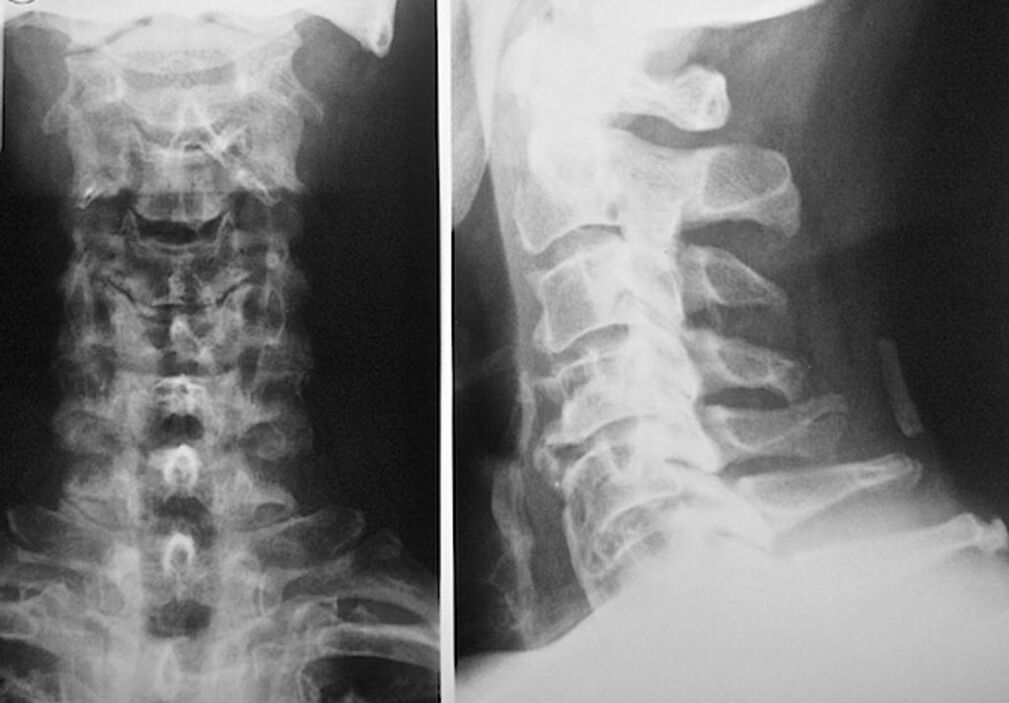
Osteochondrosis - degenerative changes in articular cartilage, accompanied by partial destruction of the discs between the vertebrae. Cervical osteochondrosis is characterized by slow tissue destruction, which develops over years, between the vertebrae that support the head. If in the last century the disease was diagnosed mainly in people aged thirty or more, today orthopedists make this diagnosis even for school-age children. The treatment of osteochondrosis of the cervical vertebrae is long. Even during the period of remission, courses of maintenance therapy should be carried out.
Symptoms of the disease in the early stages
The size of the cervical vertebrae is smaller than the thoracic and lumbar. But the load on them is significant: every day a person's neck performs many complex movements. Office workers who are forced to sit in the same position in front of a computer for many hours at a time often develop osteochondrosis of the cervical vertebrae. Treatment in this case involves not only the removal of pain, but also a mandatory change in lifestyle. Sitting inactive for many hours at the monitor is a huge test for the spine.
The following causes of osteochondrosis of the cervical vertebrae can be distinguished:
- heredity;
- sedentary lifestyle;
- extreme physical activity;
- neck injuries;
- cervical spine anomalies;
- constant incorrect position of the body during sleep.
Orthopedics and neurology distinguish four stages of the disease. In the first two, the disease does not cause intense pain, but it cannot be ignored.
In the first stage, the disease manifests itself as frequent headaches, a slight tugging sensation in the neck. Almost all patients do not give importance to these mild symptoms. Headaches are attributed to fatigue or lack of sleep. Most patients prefer to simply take an analgesic pill.
Over time (sometimes this process can drag on for several years), the disease inevitably flows into the second stage. The danger of osteochondrosis is that the so-called radicular syndrome often develops. Most often, it manifests in the second stage and worsens further as osteochondrosis progresses. Radicular syndrome is a pinched nerve ending in the cervical vertebrae. After that, many other pathologies join the headache. This is a deterioration of vision and hearing, impaired functioning of the vestibular apparatus, unbearable migraine with and without aura, numbness of the hands.
As a rule, patients go to the doctor only after manifestations of radicular syndrome. Above all, they are only concerned with their symptoms. The treatment of osteochondrosis of the cervical vertebrae and the necessary rehabilitation will not be able to neutralize all the consequences that the radicular syndrome brings with it. You can only temporarily stop the development of the disease and avoid further complications.

Manifestations of the disease in later stages
There is also a third and fourth stage of the disease, which is simply impossible not to notice. Even patients who have a surprising disregard for their health sound the alarm and go to the doctor.
The third stage of cervical osteochondrosis, if not accompanied by radicular syndrome, brings the patient a frequent and excruciating headache. Characterized by the appearance of pain directly in the neck and shoulders. The patient is forced to use ointments with a warming and analgesic effect on a continuous basis. Massage helps very well in the third stage. It is important to understand that it will not work to completely get rid of the disease. Only long-term remission can be achieved - this is the goal of treatment.
Symptoms of osteochondrosis of the cervical vertebrae in the fourth stage: a noticeable asymmetry of the spine to the naked eye and severe pain in this area. If there is also a radicular syndrome, the patient often experiences very severe dizziness, may pass out after making one or another sudden physical movement. Depending on where and how severely the nerve ending has been pinched, serious deterioration of vision or hearing is possible.
In the later stages, the appearance of an irritative-reflex syndrome is also possible, in which intense pains in the back of the head of a pulsating nature are frequent, as well as pains that descend to the thoracic spine. They can reach such force that the patient is unable to fall asleep or perform usual body movements. Such symptoms are also possible with a strong displacement of the vertebrae. Cervical osteochondrosis in later stages in 90% of cases is accompanied by an irritative reflex or radicular syndrome.
There are cases in which the disease is complicated by two of these pathologies at the same time. In this case, the treatment of osteochondrosis of the cervical vertebrae with folk remedies will not work. An integrated approach is important, which involves the use of specialized (injections, massage, physical therapy, use of analgesics) and general (swimming, exercise therapy, lifestyle) methods.

Symptoms depending on damaged nerve roots
Osteochondrosis of the 1st cervical vertebra is accompanied by numbness in the occipital region in the early stages of the development of the disease. In the later stages - the appearance of severe pain in this area. The best treatment is the use of ointments with a warming and anesthetic effect, as well as massage. Once every six months, it is necessary to inject preparations of vitamins of group B.
Osteochondrosis of the 4th and 5th cervical vertebrae is accompanied by a violation of the sensitivity of the limbs and the appearance of pain in the forearms, thoracic region. Treatment - massage of the cervical collar area and the parts of the body that become numb. Regular use of B vitamins on an ongoing basis is shown (at least once every six months, ideally once a quarter). Physiotherapy is also effective.
Osteochondrosis of the 6th cervical vertebra is accompanied by pain in the shoulders and neck. Frequent headaches. Vision may begin to deteriorate - myopia and astigmatism develop. The treatment principles are the same as in the case where other vertebrae are affected. Only with concomitant symptoms - deterioration of vision and hearing - you need to pay attention too. Regularly perform visual hygiene, do eye exercises, apply special drops that relax the optic nerve.
Osteochondrosis of the 7th cervical vertebra is accompanied by damage to the nerve endings in the region of the fifth, sixth and seventh vertebrae. It occurs in men and women at any age. This is the most common osteochondrosis of the cervical vertebrae. Symptoms of pinched nerve endings C6 and C7 are periodic numbness of fingers and hands, pain in the neck, forearm and lower part - shoulder blade, back, even the lower back.
Diagnosis of osteochondrosis: which doctor to contact
To diagnose and prescribe a course of treatment for osteochondrosis of the cervical vertebrae, you must sign up for a consultation with a neuropathologist and orthopedist. A neurologist can prescribe medication for the manifestations of the disease, which affect the state of the nerve endings. This makes sense if the disease is accompanied by radicular syndrome. The orthopedist will assess the condition of the spine and diagnose the presence of additional diseases: scoliosis, lordosis, etc.
For the diagnosis and accurate assessment of the condition of intervertebral discs, the following research methods are used:
- X-ray.
- computed tomography.
- Magnetic tomography.
- Ultrasonography of the cervical vessels.
Each of them is completely safe for health and poses no threat of overexposure. The diagnosis of osteochondrosis of the cervical vertebrae, whose treatment will be carried out throughout life, can be performed after a simple visual examination. Any orthopedist can easily do this. An exception is the first stage of the disease, when visible pathologies of the cervical region are not noticed.

Traditional medicine treatment methods
How to treat osteochondrosis of the cervical vertebrae? Whichever method you choose, it should be remembered that in order to achieve remission, you will have to regularly monitor the condition of the neck. Osteochondrosis cannot be completely cured. After some time, the symptoms will definitely make themselves felt again, and their intensity will directly depend on the patient's attitude towards his own health.
Here is a list of the most effective measures to get rid of osteochondrosis symptoms:
- physiotherapy;
- cervical collar area massage;
- taking painkillers;
- a course of group B vitamins;
- physiotherapy;
- swimming.
The patient must remember not to practice athletics (running, jumping, plyometric exercises), strength physical conditioning. This will inevitably lead to a worsening of the condition. You cannot sit in one position for a long time. Even though office work involves long hours spent at the monitor, once an hour you need to get up and do a ten-minute warm-up of the collar zone, light stretch.

Complex of physiotherapy exercises for cervical osteochondrosis
Treatment of osteochondrosis of the cervical vertebrae at home can be done with the help of special exercises. They must be carried out daily, otherwise a noticeable result cannot be expected.
- Stand on the line. Raise your hands, breathe, stand on your toes and stretch as much as possible. Do several repetitions.
- Starting position - standing, back straight, arms lowered freely along the body. Touch the left ear to the left shoulder, the right ear to the right shoulder. Perform ten times in each direction at a slow pace, without making any sudden movements.
- The starting position is the same as in the previous exercise. Touch your chin to your sternum, then gently tilt your head back. If the movement is accompanied by pain or discomfort, it should be abandoned.
- Sit in a chair or on a hard floor with a straight back. You can cross your legs in the lotus position. Perform circular head rotations - first clockwise, then counterclockwise.
- Lie on the hard floor on your stomach. The arms and legs are extended. Exercise "boat": tear the surface of the head, arms and legs and try to lift them as high as possible. Stay in this position as long as possible. This exercise is useful not only for the cervical spine, but also for the thoracic and lumbar spine.
Physiotherapy exercises should be performed carefully, at a slow pace. Sudden movements can lead to increased pain.
If it is possible to perform exercises after a therapeutic warming massage of the cervical collar area - wonderful. This way of combining two treatment methods at the same time is very good.
Pain block syndrome in osteochondrosis of the cervical spine
The main group of drugs used in the treatment of cervical osteochondrosis with displacement of the vertebrae are non-steroidal anti-inflammatory drugs (NSAIDs). Also, in relation to cervical osteochondrosis, the local use of NSAIDs in gels and ointments is preferable.
In this regard, ointments and creams with snake and bee venom in the composition are effective. Among the means for local external use, local irritants and chondroprotectors are shown.
If the pain is very severe, strong pain relievers can be used only once. Sometimes osteochondrosis is exacerbated by colds. In this case, to remove all symptoms of acute respiratory viral infections and chondrosis, drugs based on the active ingredient paracetamol will help.
The use of B vitamins in traditional disease therapy
Why do neuropathologists invariably prescribe group B vitamins as part of the complex treatment of osteochondrosis of the cervical vertebrae? The explanation is very simple. With radicular syndrome, nerve endings suffer and vitamins are the easiest way to support their functioning. The most effective form of application is intramuscular injection. When taken orally, B vitamins are only partially absorbed. When administered intramuscularly, they almost instantly enter the bloodstream.
Treatment of osteochondrosis of the cervical vertebrae at home
For complex treatment, it is not necessary to go to the hospital. It is quite possible to achieve remission at home. It is very good if the patient is able to inject independently. So you can't be at the clinic every day.
Methods for the treatment of osteochondrosis of the cervical vertebrae with folk remedies:
- Baths with salt and soda bring pain reduction, relaxation of the whole body. This is especially good before bed. You should take a full bath of water at moderate temperature and dissolve a kilo of salt and about 500 grams of soda in it.
- Paraffin applications are excellent. Melt the paraffin or wax, let it cool to a comfortable temperature and apply it to the damaged area. These compresses can be done 2 times a week.
- To reduce the inflammatory process, you can take a decoction of herbs. You need to mix 1 tbsp. I. John's wort, chamomile, marigold and yarrow flowers. For them, add 1 tbsp. I. thyme and dandelion leaves. Now you should take 2 tbsp. I. the resulting mixture and pour a liter of boiling water, insist. For 3 weeks, it is enough to take a decoction of 1/4 part of a glass 3 times a day.
- If you do not trust pharmaceutical preparations, you can prepare an ointment for the treatment of cervical osteochondrosis. You will have to take coriander fruit, birch buds, dandelion roots, peppermint grass in equal parts. Grind three tablespoons of the powdered mixture, pour in 1/2 cup of boiling water and cook for 5 minutes. To the resulting mass, add 75 g of vegetable oil and pork fat. Cool and rub the affected 4 times a day. Store the ointment in the refrigerator.
- Good help with osteochondrosis and compresses. For example, honey and potatoes. Grate a large tuber on a fine grater and mix it with honey in a ratio of 1: 1. The resulting mixture is applied to the affected area for 45 minutes.
With osteochondrosis of the cervical vertebrae, massage is the number one remedy for reducing tension and pain. To do massage therapy by yourself, you need good flexibility. Older people often can't even lift their arms to the desired height. But they find a way out of the situation: they ask one of the younger relatives for a massage.

Patient feedback on therapy outcome
According to numerous reviews of orthopedic patients and neurologists, the optimal method of treatment is the use of all procedures in combination. It is useless to use only methods of treating osteochondrosis of the cervical vertebrae with folk remedies.
Some patients note that a course of procedures with a good massage therapist literally brought them back to life, their ability to work increased.
Some patients respond positively exclusively to physical therapy exercises. They started exercising regularly at home, bought a pool membership for therapeutic swimming courses. Yoga and regular exercises to stretch the spine have helped some. Feelings after such asanas: lightness in the body, absence of pain, relief from stress.
If you regularly load your body with this type of activity, you can go into long-term remission and forget about the symptoms of osteochondrosis of the cervical spine.



















